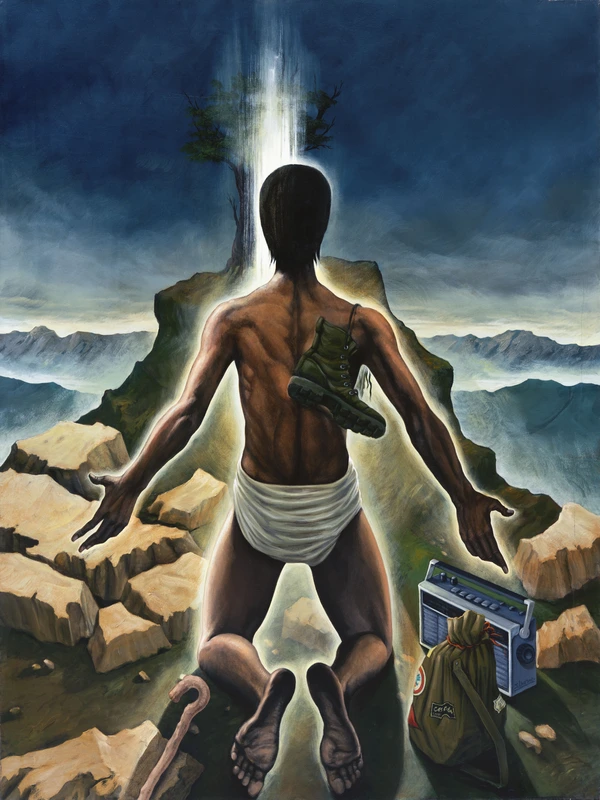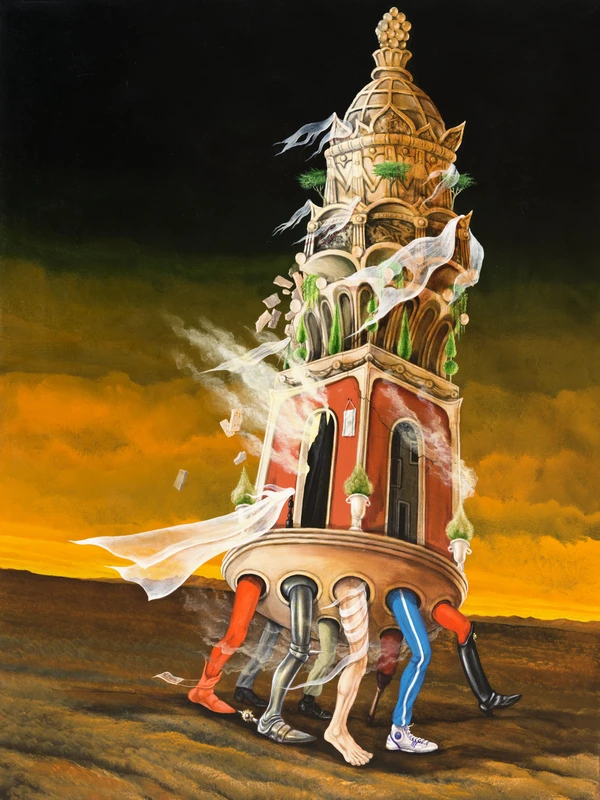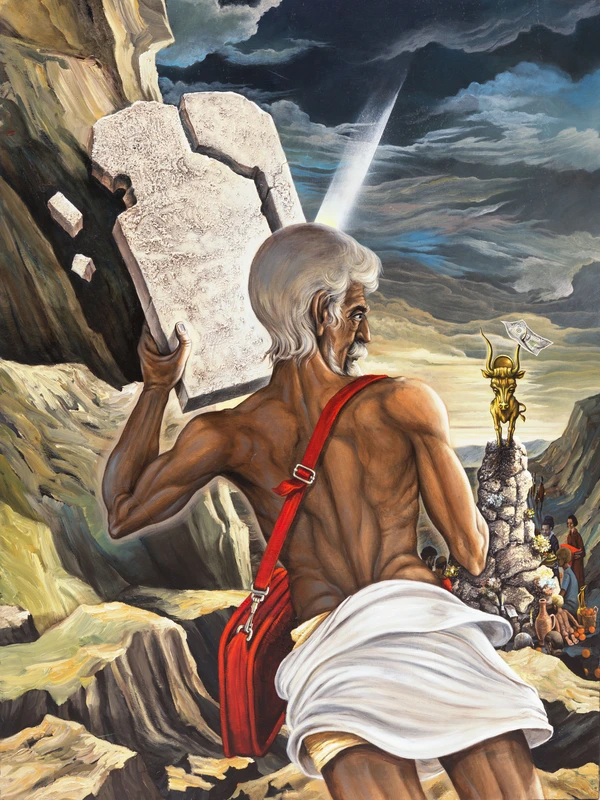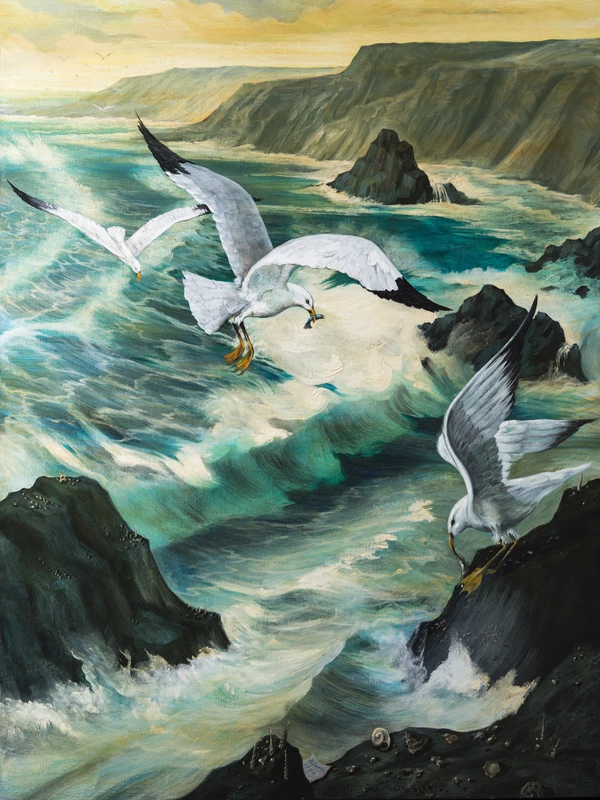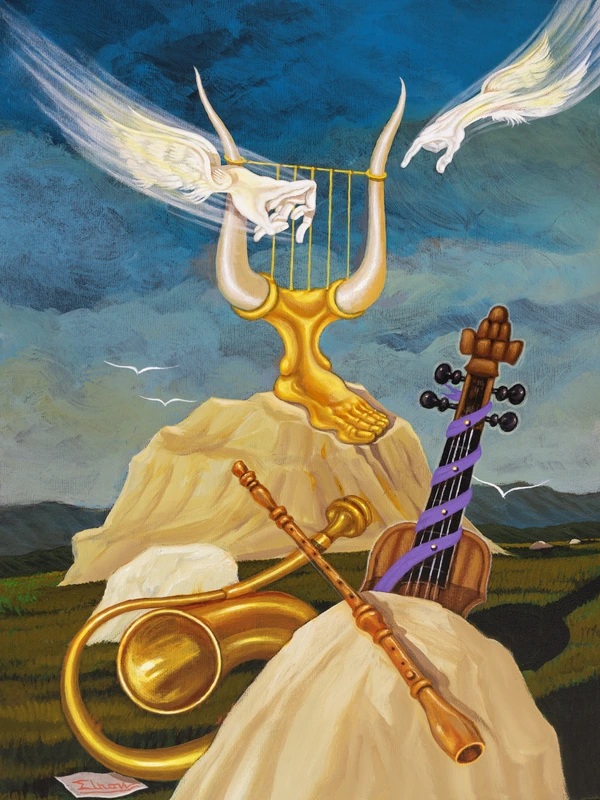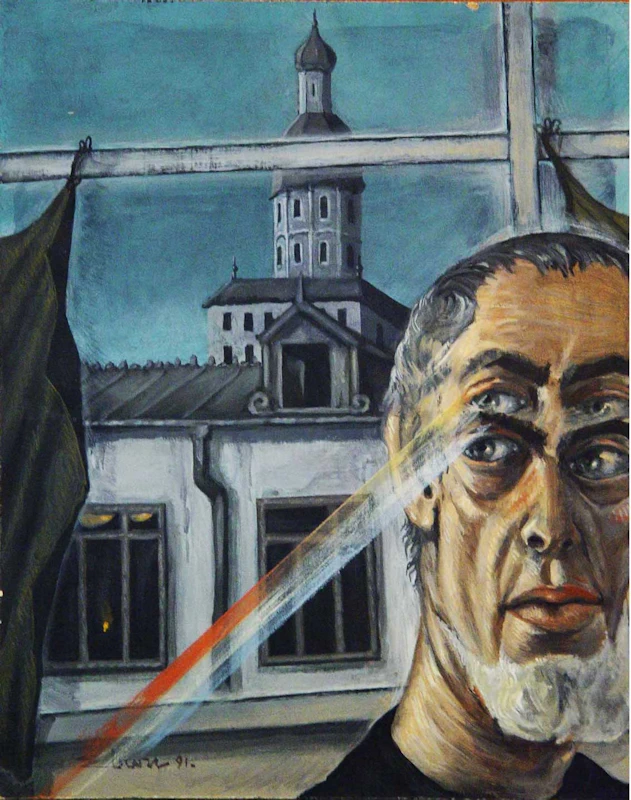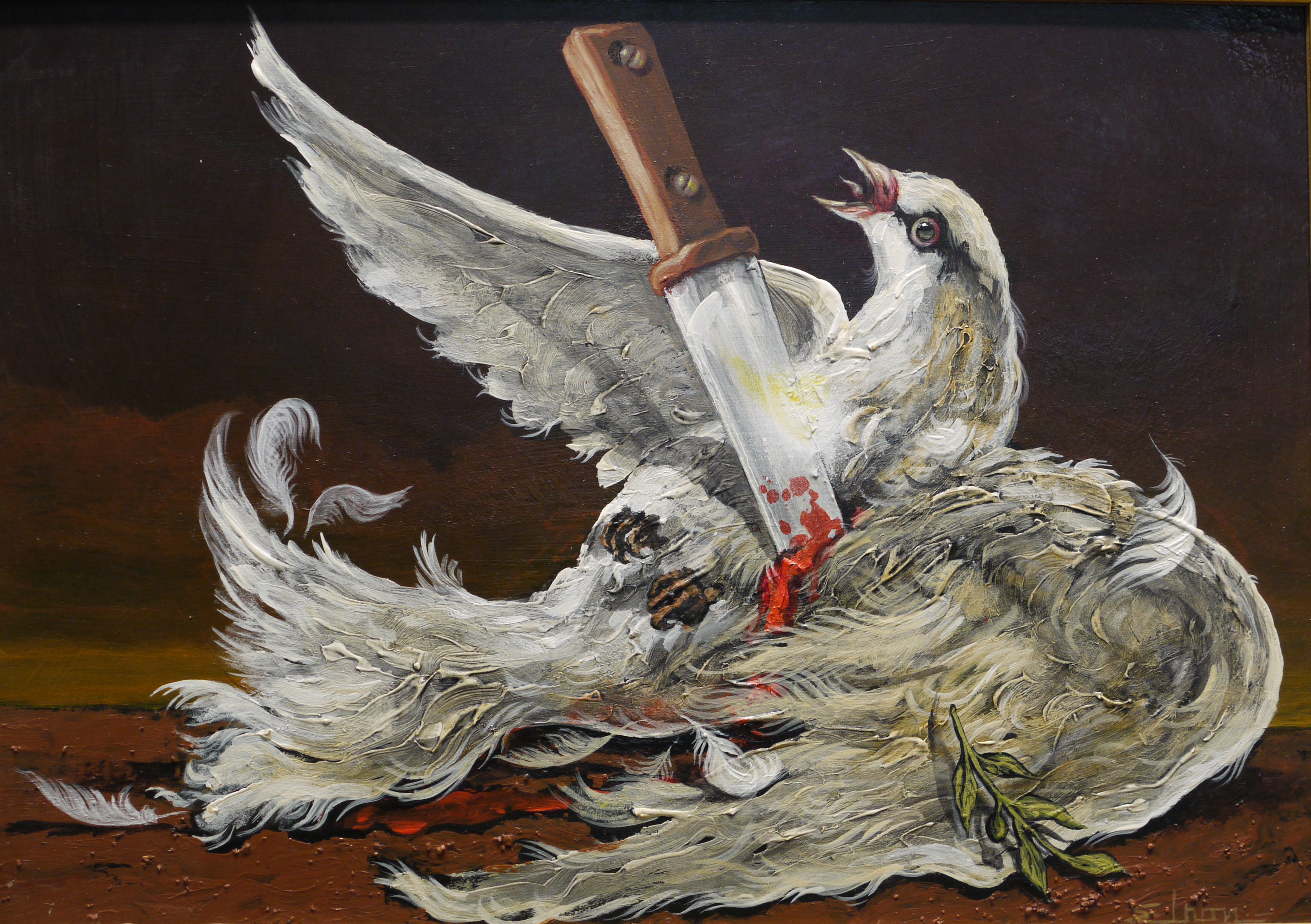The exhibition "Israel – Loss of Hope, Resurgence, Strength, and Vision in the Art of Painter Baruch Elron" in honor of the artist's 90th birthday.
Exhibition Opening: Wednesday, February 7, 2024
Exhibition Closing: Wednesday, April 3, 2024, at 6:00 PM.
ISRAEL – LOSS OF HOPE, RESURRECTION, HEROISM AND VISION IN THE ART OF BARUCH ELRON
Baruch Elron (originally Barbu Theodorescu) was born in Bucharest in 1934 in a Jewish Sephardic family, and immigrated to Israel in 1963. Today, as we celebrate the 90th anniversary of his birth, this exhibition at the Moshe Castel Museum of Art in Ma’ale Adumim serves to remind us of one of the most original, brilliant, and unique artists to have worked in Israel.
Baruch studied painting at the Nicolae Grigorescu Fine Arts Academy. As a student, he traveled to Moscow, Prague, and Budapest, where he visited museums and discovered the works of the great masters: Rembrandt, Rubens, Van Dyck, etc. After graduating from the Academy, he began to work as a book illustrator and graphic artist, receiving a prize at the Dresden Book Fair in 1960.
Baruch and Lydia Elron immigrated to Israel in 1963, two years after their marriage. It was a very difficult time to start an artistic career in a new country, yet he was determined to pursue his dream. Crucially, in the 1950s Romanian art was dominated by realism, although a certain influence of Impressionism was palpable, as well. And, since Romania regarded the Soviet Union as its political and cultural guide, all forms of abstract art were banned unconditionally. The situation in Israel was strikingly different: the “New Horizons” artistic movement, which had been founded in 1948, and soon virtually took over the galleries and exhibition halls, greatly valued and closely followed the abstract expressionist trends that dominated contemporary American art. Naturally, figurative painting as such was considered utterly obsolete, especially when it came to realism.
Despite this, Baruch Elron was determined to follow an artistic destiny. However, his background was insufficient for a position at the Bezalel Academy or the Avni University of Art and Design in Tel Aviv, then the leading institutions providing artistic training in Israel. So, he took the jobs that were available to him, even though they could not improve his social standing. To name a few, he worked at the Popular University, as well as at the Warrior’s House (the center for assistance and rehabilitation of veterans), where he taught painting years before art therapy became a widespread curative technique. Naturally, none of his students could become professional painters, because those who viewed art as their vocation would rather apply to Bezalel or the Avni Institute. However, Baruch Elron eventually managed to establish himself as one of the country’s top artists, earning wide recognition and glowing acclaim. He was finally noticed, and began to exhibit nationwide, as well as abroad.
In 1966, his first solo exhibition took place in Tel Aviv, and it was followed by many others, including a number of exhibitions in the USA, Canada, and Germany. The preface to the catalogue of his exhibition in Germany said: “He constructs a bridge between the worlds of the West and the East. Baruch Elron uses a language that borrows vocabulary from Judeo-Christian mystique and symbols. He owes his mode of expression, to a great extent, to the Italian Renaissance style. The artist succeeds in shaping the image of a personal reality, one which penetrates the viewer and which the viewer must accept. Yet, this does not provide him with an escape hatch. Elron’s works are accessible, through their meaningful content, to the viewer, as much as they are to the artist himself. Thus, the artist shows a profoundly human path, one full of hope and optimism”.
Baruch Elron started out as a follower of philosophical realism, and evolved into a surrealist, yet he always remained a figurative artist. He was a philosopher-painter. One of the great examples of his profound philosophical vision is the series of fifteen paintings titled “Beyond the Word,” which deal with a range of subjects, including stories from the Book of Genesis (e.g., Noah’s Ark, the Tower of Babel, the Binding of Isaac), the Tablets of the Law received by Moses on Mount Sinai, the conquest of Jericho, and the lives of Samson, Jonah, and Jeremiah, but even these paintings present contemporary interpretations of these events and characters. As Belgian art critic Stephan Ray put it, “Baruch Elron’s works are painted with astonishing technique; they stunningly combine symbols and allegorical images, some borrowed from the Bible, and some taken from the myths.” However, the crucial point is that Baruch Elron gave a new meaning and dimension to all the events and stories he used. In his interpretation, the ancient heroes seem to relate to the present day.
Upon their arrival in Israel, Baruch and Lydia Elron started a new life in Pardes Katz, one of Israel’s poorest regions. All he had was his talent and devoted enthusiasm. The couple lived there for seven years, before moving to Petah-Tikva, and then to Herzliya. They finally settled in Tel Aviv in 1994. The story of Baruch and his wife Lydia is a rare example of an immigrant family that is able to enter the social and cultural elite of a new country, something that became all the more obvious when Baruch was elected chairman of the Israeli Painters and Sculptors Association. He retained this position for seven years, during which he supported artists of all ages and expanded the international ties of the Association. He participated in numerous group exhibits, and also held many one-man shows in Israel and abroad (São Paolo, Paris, Basel, Dusseldorf, Cologne, New York, etc.). Even in his final years, he persisted in his artistic endeavors, and was particularly fond of teaching. He passed away at the age 71, on Sunday, March 6, 2006.
Baruch Elron was, without doubt, a great master of the brush, of color, of vigorous artistic ideas. He used a language that borrowed vocabulary from the Judeo-Christian mystique and symbolism. Elron was influenced by Hieronymus Bosch (1450–1516), Giuseppe Arcimboldo (1527–1593), and by the Art Nouveau style of the turn of the 20th century. Despite absorbing various influences, especially the great Belgian painters René Magritte (1898–1967) and Paul Delvaux (1897–1994), he always remained independent. His work was outstanding in the balance between colour and graphic elements, and it transmitted a detailed and precise picture of his ‘wonderland’. In his artworks, Elron demonstrated a unique fantasy, thrilling irony, allegorical similes, an extraordinary technical brilliance, and outstanding imagination, combined with humor and grotesque. The backdrops of his works were painted with the same degree of detail as the subjects that represent the content and essence of the painting. Despite being highly susceptible to the vectors of the development of global art, the artist succeeded, thanks to the richness of his imagination and his dreams, in creating a body of work that is personal, luscious, surprising, sometimes troubling, and perhaps worrisome.
Baruch Elron’s style and manner were largely shaped by the influence of fantastic realism. However, some of his works display a hyper-realistic approach, which makes the graphic rendition of the story so piercing.
“Self-Portrait in Gas Mask,” created in 1991, is a perfect example. That was a dramatic year, in which Israel’s territory suffered more than forty bombings by Iraqi forces during the Gulf War. Every time there was an air-raid alarm, a military spokesman would appear on air, calling on the citizens to immediately put on gas masks and go down to the bomb shelters. A memorable photo shows the famous violin player Isaac Stern, who was giving a concert with the Jerusalem Symphony Orchestra, when an air-raid alarm went off, and most of the listeners put on the gas masks they had with them, while the musicians left the stage. Still, Stern remained onstage and began to perform the famous Chaconne by J.S. Bach. But even in those days, Baruch Elron never abandoned his artistic calling and continued working, no matter the circumstances.
In the last years of his life, he was very ill, and underwent a number of complicated surgeries. Nevertheless, he worked until the very last day of his life. Even when he could no longer go outside, and had to stay indoors, he painted a whole series of original works inspired by the view of downtown Tel Aviv that opened up from his window. In these works, the city turns into a gateway enticing the viewer to join the artist on a journey through time and space.
Baruch Elron often used a creative symbolic language and left it up to the viewer to decipher his message. The painting “The End” shows a huge brush that is tied up in a knot like a ribbon or rope, resembling a wondrous living thing sitting on a wooden pier by the sea. Crystal-clear waves splash around it, crowned with transparent foamy crests, glittering with fleeting reflections of the sunbeams. The fantastic creature gazes at the distant bluish horizon that blurs into the sky. In this painting, the artist finally pays tribute to his loyal friend, which has given form to all his dreams and images, but has always stayed out of the picture – the brush. To honor it, he paints some sort of portrait, where the brush is a living thing, a live character. All its life, it has faithfully served its master; it has always been there for him to help him pour his heart out on the canvas, to guide his creative hand. And now, it has earned the right to rest and sit by the seaside looking at the waves. The artist has finished his last canvas; the journey on earth is over for him now, and so it is for the brushes that have made all this possible. They will never feel the touch of his deft hands again, and neither will he dip them into the paint to create a new work of art…
Books and articles on Baruch Elron’s legacy have been published in English, French, Spanish, German, Romanian, as well as in Hebrew. Thus, more and more people who appreciate genuine art get the chance to discover his works and take a breathtaking journey into worlds unseen.
Dr. Alek D. Epstein, Curator, The Moshe Castel Museum of Art in Ma’ale Adumim

